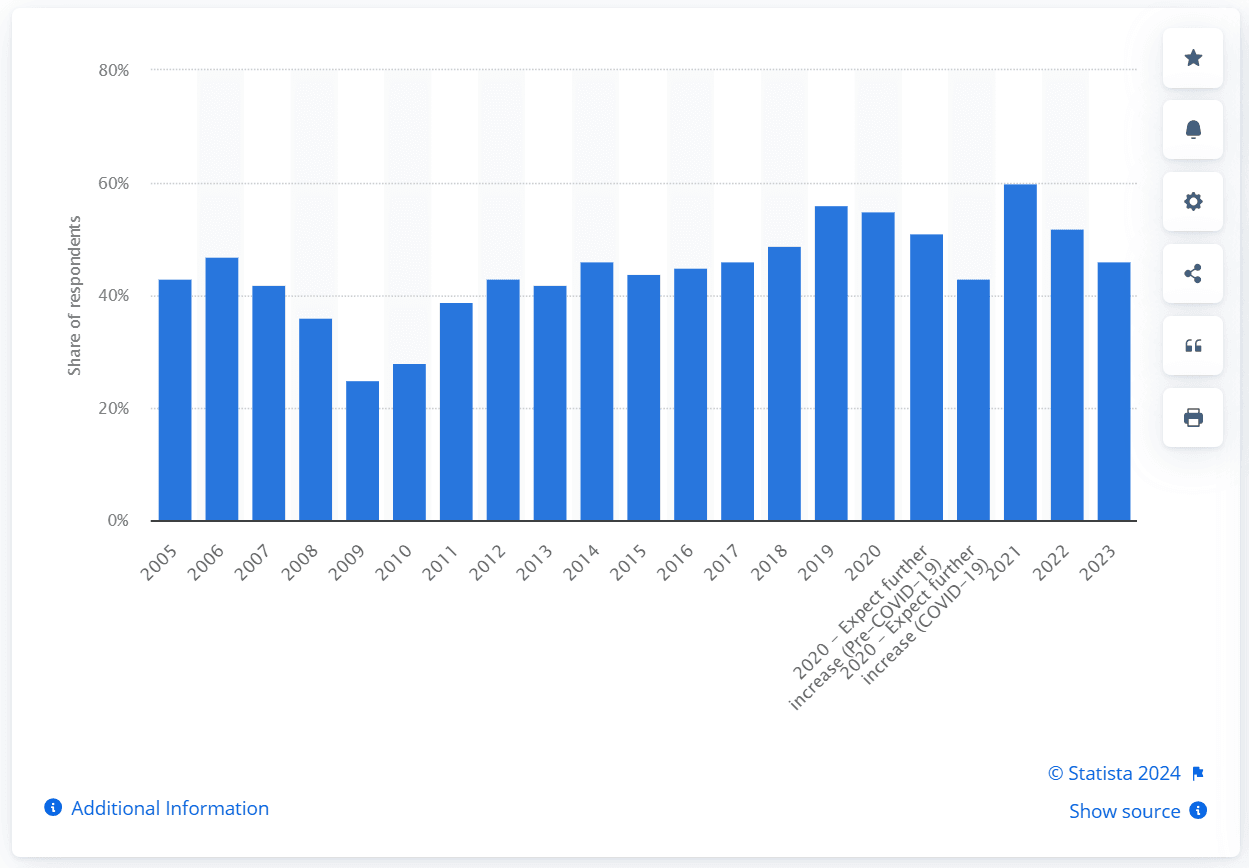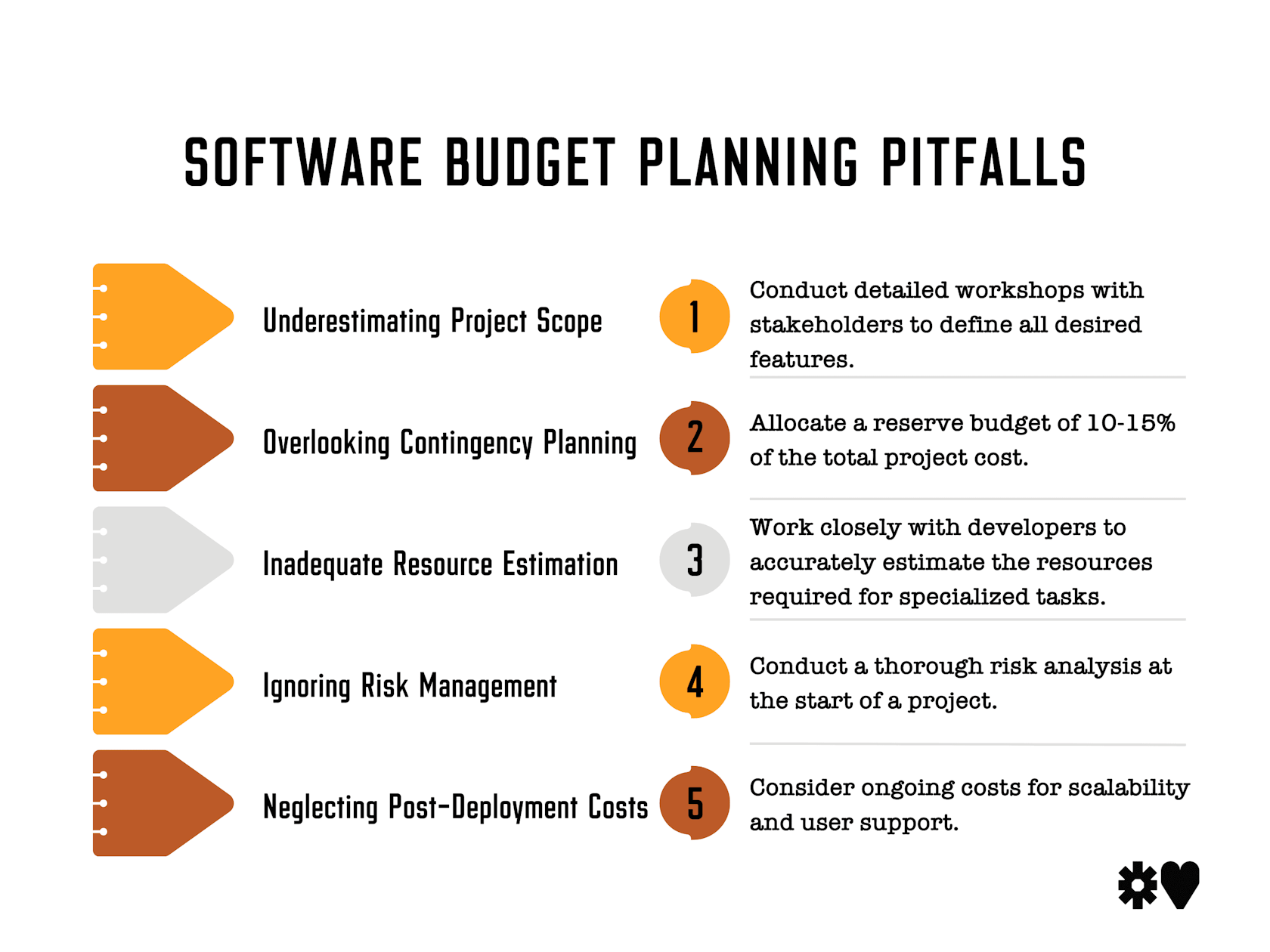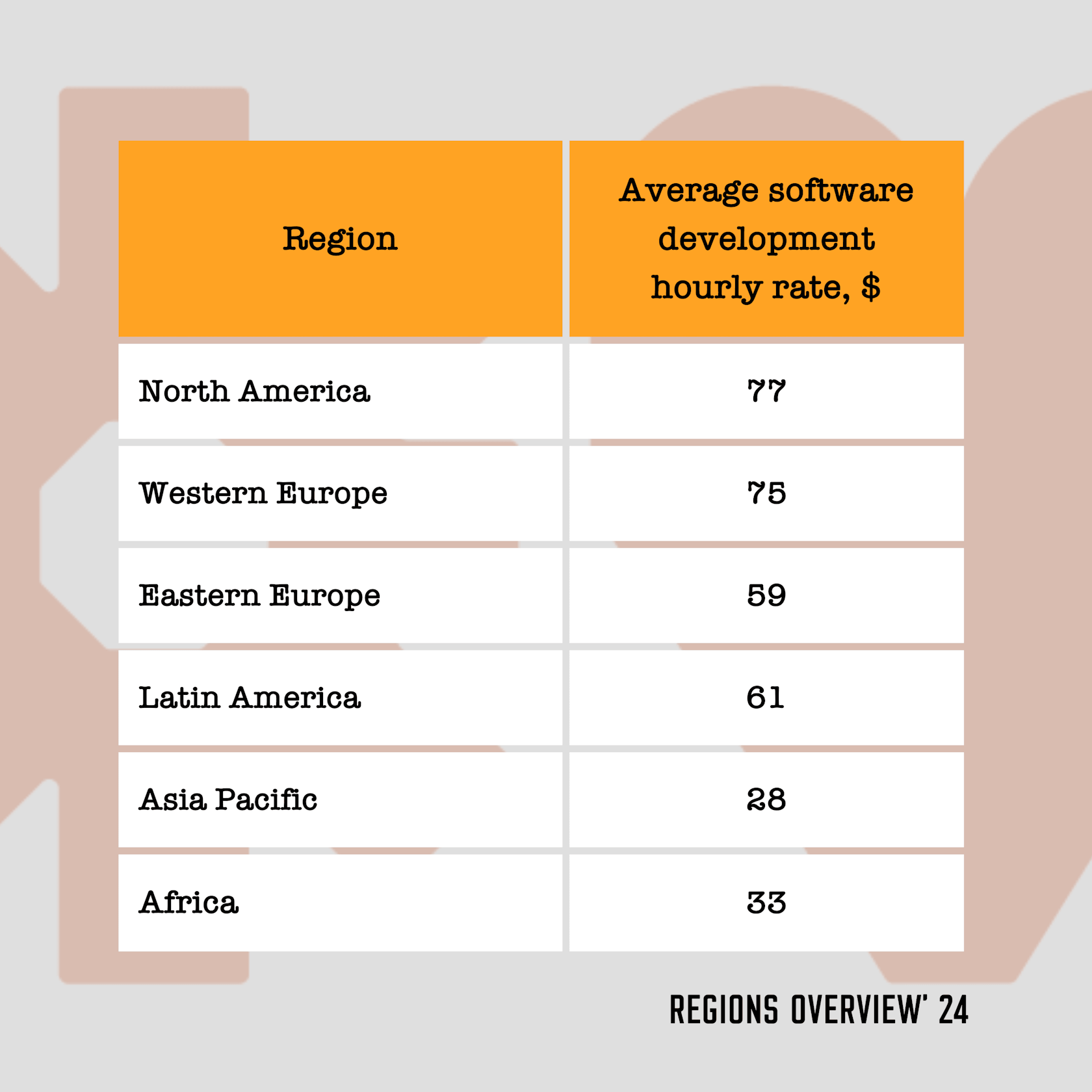Budget planning is crucial for any project, and the IT development team is no exception. For software development, budgeting helps ensure sufficient resources to complete the project while minimizing waste and maximizing efficiency. With a well-thought-out budget plan in place, it can be easier to allocate funds effectively. This can prevent unexpected costs or underfunding of necessary tasks, leading to delays or even project failure. Moreover, budget planning allows you to estimate costs accurately from start to finish by considering all aspects of software development: design through coding and testing phases until final deployment.
So let's dive into the world of software development budgeting and learn how to prepare an accurate estimate for your next project.

5 STEPS TO DEVELOP A SOFTWARE DEVELOPMENT BUDGET PLAN
Developing a software development budget plan can be a challenging task, especially when you need help figuring out where to start. Whether you're developing an application, website, or custom software solution, having a well-structured budget plan is essential for the success of your project. Here are five steps to help you develop an effective software development budget plan.
1. Determine The Project Scope And Requirements
Scope Determination
At the first stage, it is important to formulate the goals and objectives of your project clearly. State your main expectations. It would be better if you create documentation in which you describe the functionality and capabilities of your application. At the same time, it would be good to divide the features into necessary and desirable.
Requirements Gathering
Close communication with various groups from stakeholders to end users works best. To ensure comprehensive coverage, you will likely need several sessions of interviews, workshops, and surveys. Based on the data obtained, you can create a requirements document, a kind of handbook for the entire project team. And as requirements evolve, you should update this document.
2. Break Down the Project into Phase
The workflow you plan for your team will depend on the specific software development methodology you choose. Whatever approach you choose, the most important thing is to break the project down into clearly defined steps. For example, if you use Agile methodology, you can structure your planning around specific sprints or time-bound product addition milestones.
Task Identification
Decompose the project into manageable tasks or work packages. Tasks could align with project phases such as planning, design, development, testing, and deployment.
Identify dependencies between tasks to create a realistic sequence of activities.
Activity Definition
For each task, break down the work into specific activities. For example, the development phase may include coding, code review, unit testing, and integration testing.
Clearly define the inputs and outputs for each activity.
3. Estimate Resource Requirements
Resource Identification
Identify the human resources, equipment, software, and any external services needed for each task. This includes developers, designers, testers, project managers, and any specialized tools or technologies. Consider the availability and skill sets of team members.
Time Estimation
Work with project managers and team leaders to estimate the time required for each task and activity. Use historical data, experience, and any project management tools available to make realistic estimates. Please be aware of any known limitations that may affect the timing.
For example, to create the most accurate estimates, we use the task and time management platform Timer, which we created for our needs.
4. Estimate Costs
Cost Breakdown
Break down the costs associated with each resource, including salaries, benefits, and overhead costs. Consider both direct costs (easily attributable to the project) and indirect costs (administrative expenses, office space, etc.). Include costs for hardware, software licenses, and any external services.
Costs such as new hardware, software, and required infrastructure upgrades are easier to quantify. They can be quantified relatively easily and usually represent a one-time investment.
Labor costs are more difficult to predict. It is better to start by calculating the labor costs associated with a certain duration of work of the team or its individual specialists.
For example, a weekly sprint of 6 hours per day for a 3-person development team could cost $5,400 (based on $60 per hour, 5 days of 6 hours).
Then use historical data to estimate how many such increments will be needed at each stage. Once you have calculated the labor costs for each phase, you can combine them to predict the overall labor cost estimate for the entire project.
Budget Calculation
Sum up each task and activity costs to calculate the overall budget. Create a detailed budget breakdown, showing the allocation of funds to different aspects of the project.
5. Factor in Contingencies and Risks
Contingency Planning
Allocate a contingency budget to account for unforeseen events or changes in project scope. This could be a percentage of the overall budget set aside for emergencies. Be transparent with stakeholders about the existence and purpose of the contingency fund.
Risk Assessment
Identify potential risks that could impact the project timeline or budget. This could include technical challenges, changes in requirements, or external dependencies. Develop mitigation strategies for high-impact risks and allocate additional funds if necessary.

5 PITFALLS IN PLANNING A BUDGET FOR SOFTWARE DEVELOPMENT
Pitfalls are inevitable in any budget planning process, and software development is no exception. Here are five common pitfalls to avoid when developing a budget plan for a software project.
1. Underestimating Project Scope
Example
Let's say a team is developing an e-commerce website whose initial scope is focused on basic product listings and checkout functionality. However, stakeholders later express the need for comprehensive inventory management, real-time order tracking, and personalized recommendations for users. If the original project scope did not take these features into account, the team might underestimate the development effort, leading to delays and budget overruns.
Mitigation
Conduct detailed workshops with stakeholders to define all desired features. Clearly document scope and prioritize features to meet expectations. Regularly review and update the project scope as requirements evolve.
2. Overlooking Contingency Planning
Example
The software project involves integration with a third-party API for payment processing. Midway through development, a third-party service announces a major update that requires significant integration changes. Without a plan to deal with these unforeseen changes, the project may face delays and increased development costs.
Mitigation
Set aside a contingency budget, say 10-15% of the total project cost, specifically for potential changes to third-party services or other unforeseen issues. Discuss with stakeholders the potential for external factors to influence the project and the need for flexibility.
3. Inadequate Resource Estimation
Example
In a mobile app development project, the team underestimated the complexity of implementing a new AR feature. As a result, they assign fewer experienced AR developers than needed, resulting in slower development rates and potential quality issues.
Mitigation
Work closely with experienced developers to accurately estimate the resources required for specialized tasks. Regularly reassess skill requirements and adjust team composition as the project progresses.
4. Ignoring Risk Management
Example
In a software project, a critical third-party service may experience downtime, impacting the project timeline. If the team does not identify this risk and have a contingency plan in place, the project may face delays and increased costs.
Mitigation
Conduct a thorough risk analysis at the start of a project. Identify potential risks and develop mitigation strategies. Review and update the risk management plan regularly throughout the project life cycle.
5. Neglecting Post-Deployment Costs
Example
The company is developing a CRM system without taking into account the ongoing costs of data storage and user support. Once deployed, as the user base grows, the costs associated with scaling the infrastructure and providing adequate support exceed the initial budget.
Mitigation
When planning your budget, consider ongoing costs for scalability and user support. Clearly communicate to stakeholders that the budget extends beyond the initial development phase and includes post-deployment costs.

WHAT INFLUENCES DEVELOPMENT COSTS?
The costs associated with your software development projects can be influenced by various factors, so it is important to consider the specifics of your project. Here we dive into the main aspects that can affect your overall costs.
Product-Wise
Project Type
New software development costs vary depending on features and development time. The minimum viable product (MVP) for a mobile app can be $5,000, while a full-scale app can cost upwards of $150,000. Software integration prices vary by system and design. Pre-built integrations can cost several thousand dollars, while custom development costs more. Web development costs range from $10,000 for a basic design to $150,000 for complex projects, depending on the length and complexity of the project.
Project Size and Complexity
Small software development projects, often completed by individuals or small teams, take anywhere from a few weeks to a month. Medium projects involve several specialists and usually last several months. This kind of project can be a simple mobile application or a web interface to an existing system. Large software projects that require a full team are designed to span several years with ongoing support and support. Such projects involve the development of multi-platform applications and large business systems. Enterprise systems are high-quality, custom applications for large organizations that meet specific business needs. Due to the extensive data and specialized features, such products often require increased security.
Technology Stack
The technology stack and platform you choose can have a significant impact on your budget. Different technologies have different levels of complexity, scalability, and associated licensing costs. For example, choosing open-source technologies can help minimize licensing costs, while choosing proprietary software can result in higher upfront costs. It is critical to carefully consider these factors when making decisions to align technology choices with budget constraints and overall project goals.
Third-Party Integrations
Incorporating external services, APIs, or software solutions into your software project can impact your budget. Certain third-party integrations may incur licensing fees or require additional development effort, thereby increasing the overall cost of the project.
Development-Wise
Development Team
Having a larger team with different skills usually means a larger budget. This makes sense since each person you add brings their own experience, but it also means you'll need to allocate more funds to pay their salary or fees. Skilled developers and specialists often receive higher salaries or rates compared to those new to the game. But remember, it's not just about the developers. Depending on your project, you may need other specialists, such as UX/UI designers, QAs, PMs, BAs, or DevOps experts. Each of these roles adds value to your team, but also increases your overall budget.
Here are recent stats on the software development rates by region based on data from UpWork, PayScale, Indeed, and SalaryExpert.

Hiring Type
Deciding whether to do the development in-house or outsource it to another company can have a significant impact on your budget. If you decide to keep everything in-house, you will have more control over the process, but it may cost you more in the long run in terms of paying staff and setting up the necessary infrastructure.
On the other hand, outsourcing can save you money as you tap into the expertise and resources of an outside team. They have everything set up already, so you don't have to worry about additional costs.
Time and Materials Model or Fixed Price
Both options have their pros and cons. The time and materials model allows for more flexibility because you can adjust things as you go, but it can be more difficult to predict the final cost at the outset. Meanwhile, a fixed-price model gives you more budget certainty, but you may end up paying more if the project takes longer than expected. You'll also have difficulty adjusting costs mid-development if you decide to scrap something based on various factors.
ESTIMATING PROJECT DEVELOPMENT COSTS FOR VARIOUS APP TYPES
Let's see how much it will cost to develop an app depending on its type and area of use.
App Type
| App Type | Average Cost |
|---|---|
| Web App | $ 60 000 - 300 000 |
| Hybrid App | $ 40 000 - 200 000 |
| Cross-Platform App | $ 40 000 - 300 000 |
App Area
| App Field | Factors to Consider | Average Cost |
|---|---|---|
| Education | Content delivery, user progress tracking, interactive lessons, quizzes and assessments, integration with educational resources. | $ 30 000 - 200 000 |
| Banking | Security measures for financial data, integration with banking APIs, transaction tracking, budgeting tools, user account authentication, compliance with financial regulations (e.g., PCI DSS, GDPR). | $ 90 000 - 300 000+ |
| E-Commerce | Product catalog management, shopping cart functionality, payment gateway integration, user accounts, order management. | $ 40 000 - 200 000 |
| Health & Fitness | Integration with wearable devices, data tracking and analysis, personalized user experiences, compliance with health regulations (HIPAA, GDPR). | $ 40 000 - 200 000+ |
| On-Demand Service | Geolocation services, user accounts, order management, payment processing, real-time tracking, rating and review system. | $ 50 000 - 400 000+ |
| IoT (Internet of Things) | Device integration, real-time data processing, remote control functionality, security protocols, scalability for multiple devices. | $ 50 000 - 400 000+ |
| Gaming | Game design, graphics and animation, user engagement features, in-app purchases, multiplayer functionality (if applicable). | $ 40 000 - 250 000 |
| Social Networking | Complex user interactions, real-time messaging, user profiles, multimedia sharing, backend infrastructure for data management. | $ 50 000 - 300 000+ |
CONSIDER GEARHEART AS YOUR SOFTWARE DEVELOPMENT PARTNER
Our budget planning process is transparent, efficient, and designed to ensure that you receive maximum value for your investment. With years of experience developing software products across various industries and sectors, we are well-equipped to handle projects of any size or complexity.
If you’re looking for a reliable partner for your next software development project, look no further than Gearheart. Contact us today to learn how we can help bring your ideas to life while staying within budget!




